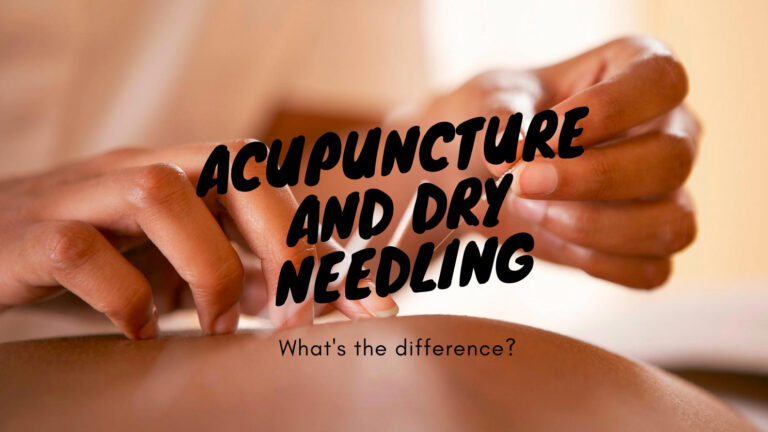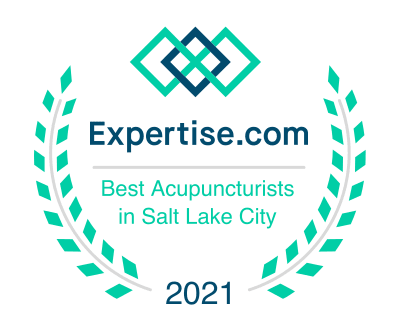Acupuncture and Dry Needling

Acupuncture and Dry Needling – What’s The Difference?
Dry needling is a myofascial trigger point technique taken from acupuncture that addresses musculoskeletal pain via trigger points in muscles. Dry Needling has emerged as a controversial issue among medical professionals due to misunderstandings and political considerations. The distinction between Dry Needling and Acupuncture exists primarily in semantics only. Acupuncture and dry needling are both evidence-based practices, with many acupuncture research studies used to dry needling claims in western medicine.
Some healthcare providers claim they are not performing acupuncture when performing dry needling. This is inaccurate. Acupuncture refers to a wide variety of needling techniques, including dry needling or trigger point needling, and acupuncture is the category where dry needling exists. This article will cover the origins of each and debunk some of the common myths that exist around Dry Needling and Acupuncture.
Origins
The first documentation of acupuncture appears in The Yellow Emperor’s Classic of Internal Medicine, which dates back to 100 BCE. This ancient practice has been cultivated and practiced for thousands of years to treat pain and other ailments in patients. More recently, in the 1980’s Janet Travell, MD published Myofascial Pain and Dysfunction: The Trigger Point Manual, which popularized the use of Dry Needling to treat skeletal pain.
Jan Dommerholt, a Physical Therapist and prominent, well-published Dry Needling expert and instructor, states that “in our program, we emphasize that Travell rediscovered trigger points” and further observes that “it is counterproductive and inaccurate to state that dry needling would not be in the scope of acupuncture, and that within the context of acupuncture, Dry Needling is a technique of Acupuncture.”
Although there is controversy in this area, many Dry Needling specialists recognize and agree that Dry Needling is a technique of Acupuncture and actively acknowledges this.
Healthy fascia is smooth and flexible, and when in a relaxed state, the layers of fascia can smoothly glide over each other with every move we make. Fascia is comprised of multiple layers with hyaluronic acid in between, acting as a lubricant to reduce friction.Fascia is a vital and powerful part of our body that is responsible for many essential functions. Some of its duties include:
- Fascia generates 30-40% of muscular power
- Chains of fascia called fascial slings help stabilize our bodies during movements such as walking, jumping, running, lifting, and throwing
- Fascia contains sensory cells that monitor muscle movement and contraction
- Fascia transfers force to and from nearby muscles
Dry Needling Is Acupuncture, But Acupuncture Is Not Dry Needling
Acupuncture is a whole-body approach to health and can help heal many ailments including musculoskeletal pain. Trigger point acupuncture uses acupuncture points that allow the needle to penetrate ‘belly’ of the muscle, eliciting the same twitch response that is being attempted with dry needling but with less pain and more accuracy. Pain usually does not occur from a singular area or event, and other areas of health need to be addressed, such as mental health, digestion, stress, and sleep, to truly make a difference in pain levels long term. In contrast, dry needling is only equipped to treat acute muscle pain in the body, and considering other aspects of health and wellness is out of scope for this practice.
How does acupuncture help myofascial pain? A technique called trigger point acupuncture.
Acupuncturists have been treating hyperirritable bands of fascia for centuries. Originally ashi points were used, first recorded by Sun Simiao in his Tang Dynasty, Qian Jin Yao Fang (Thousand Ducat Formulas). In the modern era, acupuncturists utilize the knowledge of ashi points and incorporate present-day anatomical and physiological knowledge to address myofascial pain in clinical practice. You will commonly hear this referred to as trigger point acupuncture.
To relieve fascia pain, the tight muscle fascia surrounding the muscle needs to relax. The way that acupuncture addresses this is by eliciting a twitch response. The muscle twitch is an involuntary action that helps the muscle contract and then release, unwinding the fascia rigid and tight around the muscle. This twitch response also allows more blood, oxygen, and nutrients to flow to the muscle while also relieving tension at the attachment sites, which can cause pain and inflammation. During an acupuncture treatment, the needle is inserted directly into the belly of the muscle, eliciting the twitch response.
Electroacupuncture and cupping may also be utilized to enhance the process and loosen fascia further. In addition to loosening fascia, this type of needling affects the brain, which reduces the perception of pain by the nerves associated with the trigger point.
Some common conditions associated with myofascial pain are:- Neck pain
- Lower and upper back pain
- Tendonitis and bursitis
- Repetitive use injuries
- Facial and jaw pain
- Headaches
- Shoulder and arm pain
- Knee pain
- Hip pain
- Wrist and hand pain
- Ankle and foot pain
- Muscle tightness and soreness
TRAINING REQUIREMENTS
Both acupuncturists and physical therapists take on extensive scientific education requirements in their fields of study. However, the time it takes to become certified and start needling patients differs greatly. To become certified in dry needling, Physical Therapists complete a three-day course composed of 54 hours of hands-on training. Once this is complete, they are legally allowed to practice on patients.
Acupuncturists, on the other hand, spend years in a Master’s program learning Chinese medical theory, diagnosis, and treatment as well as completing over 600 clinical hours. Acupuncturists are also required to pass 3-4 national board exams through the National Certification Commission for Acupuncture and Oriental Medicine (NCCAOM), with some states requiring an additional state test in order to practice on patients.
While both are experts in their fields of study, the difference in hands-on training and finesse when it comes to needling patients differs greatly. Acupuncturists spend over 11x the amount of time in clinical hours, perfecting the art of acupuncture to ensure a positive patient experience.
Takeaways
The most important thing is that people have a safe experience when using natural pain-relieving tools that can help maintain a full, pain-free life.
Trigger point acupuncture can help tremendously with sports injuries, chronic pain, migraines, plantar fasciitis, back pain, and more. It is extremely effective at addressing muscular pain, is low-risk, and has very few side effects.
If you experience any kind of musculoskeletal pain, give Rachel a call at (801) 903-3905 to see how trigger point acupuncture can help you!
Disclaimer: This guide is not a replacement for regular medical care or intended to treat, diagnose, cure, or prevent any disease; it is meant to support in addition to your standard wellness checkups with your doctor. Always seek your physician’s advice or another qualified healthcare provider for any questions you have regarding a medical condition and before undertaking any diet, exercise, or other health-related programs. If you are experiencing persistent and or life-threatening symptoms, contact your doctor right away or dial 9-1-1.




